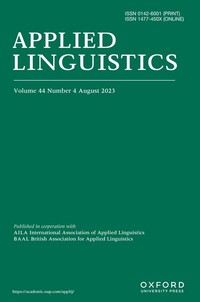“Translanguaging” in a Classroom of Native English Speakers
In a world where there are many different forms of communication – words, gestures, videos, images, even emojis – the concept of translanguaging offers a meeting point where all forms are embraced. But until now, its application has largely been confined to English as a Second Language (ESL) and English Medium Instruction (EMI) classes, where it has been used as a strategy to bridge understanding in situations where students are not native speakers of English and may be grasping for the right word.
A new study published in Applied Linguistics by Kevin W.H. Tai, Assistant Professor of Academic Unit of Language and Literacy Education and Co-Director of the Centre for Advancement in Inclusive and Special Education, aims to break through that barrier by showing that translanguaging can also be effective with students who are native English speakers.
“Translanguaging is an emerging concept that means communicating by tapping into our diverse linguistic and multimodal resources, such as body language, eye gaze, visual images or objects, to support our process in making meaning and creating new knowledge,” he said. This makes it distinct from code-switching, in which students switch between named languages.
“A very nice example is a T-shirt that has the word ‘I’ and a heart with a Hong Kong flag inside it. It creates meaning in a dynamic way that goes beyond code switching.”
In the classroom, it could be a situation where the teacher speaks Cantonese to explain a difficult concept while pointing to a textbook written in English. “The student has to make sense of and look at everything in order to understand the whole message,” he said.
Translanguaging in Multilingual Classrooms
Most research on translanguaging has focused on second language or EMI classrooms and on how it can help multilingual students empower their voice, support their identity construction, and support their learning of both content and language. But there is a lack of attention on how translanguaging might be applied in a classroom where everyone speaks English and is in the process of developing literacy skills.
Professor Tai’s study, conducted with Professor Wong Chiu Yin, Cathy, of Monmouth University, focuses on an American teacher who wanted to take her learning of translanguaging into just such a setting. The teacher had a class of first graders and wanted to use the approach to promote her students’ appreciation of linguistic and cultural diversity. The teacher was trained by Professor Wong, while Professor Tai led the work to video-record and analyse the teaching and to interview the teacher afterwards.
“There is an assumption that if you learn English as a first language, that’s sufficient because English is the lingua franca, but this teacher was trying to broaden her students’ horizons. It’s an important theoretical contribution to the field because it advocates that not only multilingual students need to expand their communicative repertoire, but native speakers as well,” Professor Tai said.
The teacher in this study used materials such as a storybook with Spanish words – not to teach her students Spanish but to help them appreciate different ways of naming things. She deployed different voices and physical movements to convey characters from the Disney movie Encanto, and introduced discussions on Hispanic festivals and cuisine. The class included several Spanish-speaking students and the teacher and other students also learned from them.
The teacher also had a higher purpose. In a country where school shootings are no longer a rarity and there is distrust of non-English speakers, she wanted to give students a sense of belonging and community. “She hopes that through translanguaging, it can help her students to better appreciate and understand cultural and linguistic diversity in the world,” Professor Tai said.
Expanding Language Perspectives
Professor Tai’s interest in translanguaging is motivated by his own experiences. He attended a Band One EMI school in the New Territories in Hong Kong and completed secondary school in Sydney, Australia. In both cases, he faced challenges understanding concepts that were presented only in English – and was helped by teachers in Hong Kong and by Chinese classmates in Australia who provided translations.
He also did his PhD on translanguaging in EMI classrooms in Hong Kong, and his doctoral project focused on the role of translanguaging in challenging the monolingual English-only policy stipulated by the Education Bureau and school managers.
“There is an issue in that not all non-native English teachers are capable of using English well to teach content, and not many students have the academic English proficiency to learn a content subject through English. So it’s very unfair to say that if you use Chinese in that situation, you must be wrong. It really depends on how you use it strategically and appropriately to achieve your pedagogical goal. For example, it may be that the teacher is referring to a blackboard that is full of English,” he said.
“We are not saying that translanguaging means teachers are free to use any available resources in the classroom, or that you should speak Cantonese 80 per cent of the time in an EMI classroom. What we are trying to say is that you can use the resources strategically and appropriately to help students to learn. But we have a lot of work to do to get the point across.”
Professor Tai would like to see more teachers willing to participate in research on translanguaging in Hong Kong classrooms. He recently received an Early Career Scheme grant from the Research Grants Council of Hong Kong for a project on the use of translanguaging to help ethnic minority students reduce their anxiety when learning Chinese as a second language. The grant proposal received full marks from the Research Grants Council (only seven of 187 projects awarded across Hong Kong received that grade). An honorary title of “Early Career Award” was awarded to Professor Tai in recognition of the quality of his research submitted in the Early Career Scheme grant bid.
“We need to remind teachers that the goal of education is about knowledge construction. If we insist on using one language only in the classroom, it restricts the amount of resources that teachers and students can use to facilitate understanding of the concept,” he said.
“Language is no longer as simple as standardised English or Chinese, it is multi-layered – it involves multilingual, multimodal, multi-sensory and multi-semiotic resources. This is really a new perspective in understanding language that captures the creative ways we communicate in our society.”

Professor Kevin Tai emphasises the importance of multilingualism in teaching and learning process.

Professor Kevin Tai's study published in Applied Linguistics by Oxford University Press explores the role of translanguaging in English-Medium-Instruction (EMI) classroom.

